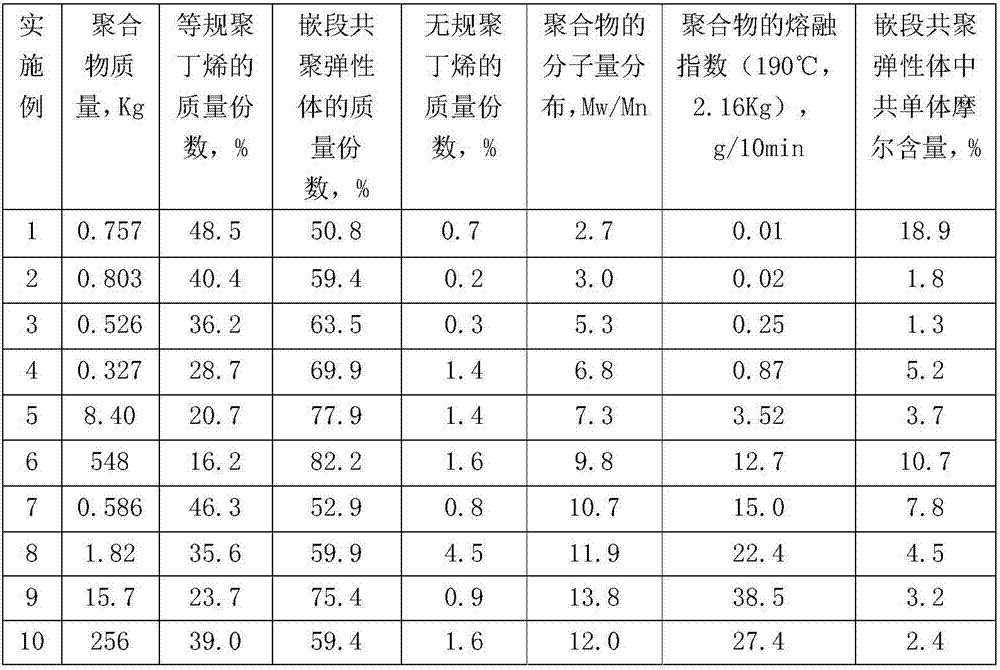Polybutylene thermoplastic elastomer and preparation method thereof
A thermoplastic elastomer and polybutene technology, applied in the field of polybutene thermoplastic elastomer, can solve the problems of sharp increase in system viscosity, inability of conversion rate to be too high, and complicated separation of post-processing procedures.
- Summary
- Abstract
- Description
- Claims
- Application Information
AI Technical Summary
Problems solved by technology
Method used
Image
Examples
Embodiment 1
[0038] 3L full-sealed magnetic stirring stainless steel pressure polymerization kettle, pumped out and replaced with high-purity nitrogen several times, then metered and added triethylaluminum (Al), external electron donor diphenyldimethoxysilane (Si ), hydrogen and MgCl 2 Loaded TiCl 4 Catalyst (Ti content 2.5wt%) 0.25g, add butene 0.4Kg, wherein Al / Ti=60 (molar ratio), Si / Ti=6 (molar ratio), H 2 1.5g. Stir and polymerize at 30°C for 5 hours, remove unreacted monomers and hydrogen under reduced pressure, then add 0.4Kg of 1-pentene, 0.4Kg of butene, and 3g of hydrogen into the reactor, react at 30°C for 8 hours, and obtain powder directly after drying. Shaped polymer 757g. The properties of the alloy are shown in Table 1.
Embodiment 2
[0040] 3L full-sealed magnetic stirring stainless steel pressure polymerization kettle, pumped and replaced with high-purity nitrogen for several times, then metered and added triethylaluminum (Al), external electron donor cyclohexyltrimethoxysilane (Si), Hydrogen and MgCl 2 Loaded TiCl 4 Catalyst (Ti content 2.5wt%) 0.25g, add butene 0.4Kg, wherein Al / Ti=80 (molar ratio), Si / Ti=10 (molar ratio). Stir and polymerize at 30°C for 2 hours, separate and recover unreacted monomers and hydrogen, then add 0.1Kg of 1-hexene, 1Kg of butene, 2g of hydrogen into the reactor, react at 40°C for 6 hours, stop drying and directly obtain powdery polymerization Material 803g. The properties of the alloy are shown in Table 1.
Embodiment 3
[0042] Two 3L fully-sealed magnetic stirring stainless steel pressure polymerization kettles were drained and replaced with high-purity nitrogen for several times, then metered and added triethylaluminum (Al) and external electron donor diphenyldimethoxy into No. 1 reactor Silane (Si) and MgCl 2 Loaded TiCl 4 Catalyst (Ti content 2.5wt%) 0.30g, add butene 0.4Kg, wherein Al / Ti=120 (molar ratio), Si / Ti=10 (molar ratio). Add 10mL of hydrogen, stir and polymerize at 0°C for 5h, then recover the unreacted monomer and hydrogen through the separation device, transfer the material to the No. 2 reactor, add 0.05Kg of 1-octene, 0.5Kg of butene, 10mL of hydrogen, The reaction was carried out at ℃ for 4 hours, the recovery of unreacted monomers was terminated, and 526 g of powdery polymers were directly obtained after drying. The properties of the alloy are shown in Table 1.
PUM
 Login to View More
Login to View More Abstract
Description
Claims
Application Information
 Login to View More
Login to View More - R&D
- Intellectual Property
- Life Sciences
- Materials
- Tech Scout
- Unparalleled Data Quality
- Higher Quality Content
- 60% Fewer Hallucinations
Browse by: Latest US Patents, China's latest patents, Technical Efficacy Thesaurus, Application Domain, Technology Topic, Popular Technical Reports.
© 2025 PatSnap. All rights reserved.Legal|Privacy policy|Modern Slavery Act Transparency Statement|Sitemap|About US| Contact US: help@patsnap.com

